The Secret of Lactylation: Unlocking New Codes of Metabolism and Disease
16 Jun 2025
by AntBio

Lactylation, a newly emerging post-translational modification, involves the binding of lactate molecules to amino acid residues of proteins, unveiling a hidden link between cellular metabolism and biological functions. This modification serves as a "barometer" of cellular metabolic states and profoundly impacts gene expression, immune responses, and disease processes. As research deepens, lactylation is becoming a key to unlocking life's mysteries.
At its core, lactylation involves the binding of lactate to lysine residues on proteins through ester bonds, creating a dynamic modification process. This process is closely tied to cellular metabolic states, especially in hypoxic or high-energy-demand environments where lactate accumulation significantly promotes lactylation. This mechanism offers a new perspective on how cells adjust their functions under metabolic stress.
I. How Lactylation Shapes Biological Functions
Lactylation plays multiple roles in cellular function regulation:
-
Gene Expression Regulator
Lactylation can directly influence the activity of transcription factors, thereby regulating gene expression levels. For example, lactylated transcription factors may enhance or suppress the transcription of specific genes, bridging cellular metabolism and gene expression. -
Cell Metabolism Modulator
Lactylation is closely linked to cellular energy metabolism, affecting the efficiency of nutrient utilization and energy production. This modification provides new insights into the dynamic regulation of cellular metabolism. -
Immune Response Participant
In immune cells, lactylation is associated with inflammatory responses and immune reactions, potentially affecting immune cell functions by modulating signaling pathways.
II.Lactylation's Hidden Link to Disease
Aberrant lactylation is closely associated with the development of various diseases:
-
Cancer's "Fuel Switch"
The high metabolic activity of tumor cells leads to significantly elevated lactylation levels. Studies indicate that lactylation may promote tumor growth and metastasis, emerging as a new target for cancer therapy. -
Metabolic Diseases' "Behind-the-scenes Pusher"
In metabolic diseases such as diabetes and obesity, lactylation influences insulin signaling and lipid metabolism, potentially exacerbating disease progression. -
Neurodegenerative Diseases' "Invisible Threat"
Lactylation's role in neurodegenerative diseases like Alzheimer's is being revealed, and it may accelerate disease progression by affecting neuronal metabolism and function.
III. Detecting Lactylation: The Bridge from Laboratory to Clinic
To investigate lactylation's functions and disease associations, scientists have developed efficient detection tools such as lactylation antibodies. These antibodies specifically recognize lactylated proteins, offering researchers a precise "magnifying glass." Techniques like immunoprecipitation and Western blot enable the detection of lactylation levels in cell or tissue samples, providing crucial clues to disease mechanisms.
Staart Lactylation Antibody: Your Solution for Lactylation Detection
L-Lactyl Lysine Rabbit Polyclonal Antibody
Catalog Number: S0B0719

Validation Data:

WB result of L-Lactyl Lysine Rabbit pAb
-
Primary antibody: L-Lactyl Lysine Rabbit pAb at 1/1000 dilution
-
Lane 1: untreated HeLa whole cell lysate 20 µg
-
Lane 2: HeLa treated with 100 mM Lactate sodium for 24 hours whole cell lysate 20 µg
-
Secondary antibody: Goat Anti-rabbit IgG, (H+L), HRP conjugated at 1/10000 dilution
-
Predicted MW: Multiple
-
Observed MW: Multiple
The Future Landscape of Lactylation
As an emerging post-translational modification, lactylation is gradually revealing its profound roles in cellular metabolism and disease. With continuous advancements in detection technologies and deeper research, lactylation is expected to become a bridge connecting metabolism and disease, offering new directions for precision medicine.




